Form Factors and Correlation Functions
“Elementary, my dear Watson”
-- Arthur Conan Doyle

One of the fundamental problems of statistical mechanics and its quantum field theory formulation is the characterization of the order parameters and the computation of their correlation functions. Beside the intrinsic interest of this problem, it is worth stressing that the correlation functions have the key for let us leaving the frame of pure theoretical formalism and getting into the real world of experiments. Indeed, they allow us to compute, among other things, transport properties and Universal Ratios of Renormalization Group -- quantities which can be directly measured in labs and used either to find the current-voltage plots or to identify the universality classes of critical phenomena.
Computation of correlation functions is, in general, a rather difficult task, usually achieved with partial success through perturbative methods. Notable exceptions are provided by Conformal Field Theories, where an exact determination of the operator content and the correlation functions of a two-dimensional theory can be obtained but only when the model is at its critical point. In this case, one has a classification of the order parameters in terms of the irreducible representation of the Virasoro algebra and, moreover, one can get an exact expression of the correlators solving the linear differential equations that they satisfy.
Unfortunately, the simple theoretical scheme of the critical points cannot be generalized once we move away from criticality. In this case, the problem has to be faced with different

techniques. A significant progress can be made when we deal with integrable quantum field theories, characterized by their elastic S-matrix and the spectrum of the asymptotic states. The central quantities are in this case the matrix elements of the various operators on the asymptotic states of the theory, called the Form Factors. The general properties related to the unitarity and crossing symmetry (the Watson
equations), together with recursive residue conditions lead to a set of functional equations for the Form Factors that can be explicitly solved in many interesting cases.
Once the matrix elements of the operators are known, their correlation functions can be recovered in terms of spectral representation series. It is worth mentioning that these series present remarkable convergence properties. Moreover, the operator content of the theory can be classified in terms of the different solutions of the form-factors equations.
Form Factors are also key quantities to investigate the behavior of two-dimensional quantum field theories in the vicinity of integrable lines and to predict confinement of excitations or their decay (see breaking integrability).
In summary, the success of the Form Factor method relies on two points: (a) the possibility to determine exactly the matrix elements of the order parameters on the asymptotic states of the theory, identified by the scattering theory; (b) the fast convergence properties of the spectral series. These two steps permit to determine correlation functions away from criticality with a precision that cannot be obtained by other methods. A significant example is given by the spin-spin correlation function of the Ising model in a magnetic field, whose scattering theory involve 8 different excitations. The Form Factor approach can be also extended to the massless flows of Renormalization Group and to supersymmetric theories.
Main References
The theory of Form Factors and application to the Sine-Gordon model can be found in
• M. Karowski, P. Weisz, Exact Form-Factors In (1+1) Dimensional Field Theoretic Models With Soliton Behavior, Nucl.Phys.B 139 (1978), 455
• F. Smirnov, Form factors in completly integrable models of quantum field theory, World Scientific 1992.
The form factors of the thermal Ising model has been studied in detail in the article
• V.P. Yurov, Al.B. Zamolodchikov, Correlation functions of integrable 2-D models of relativistic field theory. Ising model, Int. J. Mod. Phys. A6 (1991),3419
The determination of the correlators of the Ising model on the lattice and their relation with the Painleve' equation can be found in the articles
• T.T. Wu, B. McCoy, C. Tracy, E. Barouch, Spin-spin correlation functions for the two-dimensional Ising model: Exact theory in the scaling region, Phys. Rev. B 13 (1976), 316.
• B. McCoy, C. Tracy, T.T. Wu, Painleve functions of the third kind, Jour. Math. Phys. 18 (1977), 1058.
• M. Jimbo, M. Jimbo, M. T. Miwa, K. Ueno, Monodromy preserving deformation of linear ordinary differential equations with rational coefficients : I. General theory and tau -function, Physica D2, (1981), 306.
The classification of the operators obtained in terms of the different solutions of the form factor equations has been proposed in the paper
• J. Cardy, G. Mussardo, Form-Factors Of Descendent Operators In Perturbed Conformal Field Theories, Nucl.Phys.B 340 (1990), 387
The relation with CFT fields has been studied in several papers, see for instance
• G. Mussardo and P. Simonetti, Stress-Energy Tensor and Ultraviolet Behaviour in Massive Integrable Quantum Field Theories, Int. J. Mod. Phys. A 9 (1994), 3307-3337, hep-th/9308057
• G. Delfino, On the space of quantum fields in massive two-dimensional theories, Nucl. Phys. B 807:455-470,2009. arXiv:0806.1883
• G. Delfino, G. Niccoli, Isomorphism of critical and off-critical operator spaces in two-dimensional quantum field theory, Nucl. Phys. B799: 364-378,2008, arXiv:0712.2165 [hep-th]
The form factors of the Sinh-Gordon model and their cluster properties have been determined in the papers
• A. Fring, G. Mussardo, P. Simonetti, Form-factors for integrable Lagrangian field theories, the sinh-Gordon theory, Nucl.Phys.B 393 (1993), 413, hep-th/9211053
• A. Koubek, G. Mussardo, On the operator content of the sinh-Gordon model, Phys.Lett.B 311 (1993), 193, hep-th/9306044
The matrix elements and the correlation functions of the Ising model in a magnetic field have been computed in
• G. Delfino, G. Mussardo, The Spin spin correlation function in the two-dimensional Ising model in a magnetic field at T = T_c, Nucl. Phys. B 455 (1995), 724, hep-th/9507010
• G. Delfino, P. Simonetti, Correlation functions in the two-dimensional Ising model in a magnetic field at T = Tc, Phys. Lett. B 383 (1996), 450, hep-th/9605065
• G. Delfino, Integrable field theory and critical phenomena. The Ising model in a magnetic field, Jour.Phys. A 37 (2004), R45, hep-th/0312119
An experimental confirmation of these results have been presented in
• R. Coldea, D.A. Tennant, E.M. Wheeler, E. Wawrzynska, D. Prabhakaran, M. Telling, K. Habicht, P. Smeibidi, K. Kiefer, Quantum Criticality in an Ising Chain: Experimental Evidence for Emergent E(8) Symmetry, Science 327:177-180, 2010.
The convergence property of the spectral series has been analyzed by seversal authors. It is useful to consult the book Statistical Field Theory and the papers
• J. Cardy, G. Mussardo, Universal Properties of Self-Avoiding Walks from Two-Dimensional Field Theory, Nucl. Phys. B 410 (1993), 451, hep-th/9306028
• Al.B. Zamolodchikov, Two point correlation function in scaling Lee-Yang model, Nucl. Phys. B 348 (1991), 619
• G. Delfino and G. Mussardo, Two-point Correlation Function in Integrable Quantum Field Theory with Anticrossing Symmetry, Phys. Lett. B 324 (1994), 40-44, hep-th/9310130
The vacuum expectation values of several operators of integrable field theories have been determined in a series of papers.
• S. Lukyanov, A.B. Zamolodchikov, Exact expectation values of local field in quantum sine-Gordon model, Nucl. Phys. B 493 (1997), 571, hep-th/0102079
• V. Fateev, S. Lukyanov, A.B. Zamolodchikov, Al.B. Zamolodchikov, Expectation values of local fields in Bullogh-Dodd model and integrable perturbed conformal theories, Nucl. Phys. B 516 (1998), 652, hep-th/9709034
• V. Fateev, S. Lukyanov, A.B. Zamolodchikov, Al.B. Zamolodchikov, Expectation values of descendent fields in the sine-Gordon model, Nucl. Phys. B 540 (1999), 587, hep-th/9807236
The Form Factor equations for massless flows have been discussed in
• G. Delfino, G. Mussardo and P. Simonetti, Correlation Functions Along a Massless Flow, Phys. Rev. D 51 (1995), R6620-R6624, hep-th/9410117
Form factors have found interesting applications in problems of condensed matter physics, see
• F. Essler, R. Konik, Applications of massive integrable quantum field theories to problems in condensed matter physics, in "From fields to strings: circumnavigating theoretical physics", World Scientific, Singapore (2005), cond-mat/0412421
Other Relevant Publications
• G. Delfino, P. Grinza, P. Mosconi, G. Mussardo, Correlation functions of disorder operators in massive free theories, Int. J. Mod. Phys. A 19 S2: 126-133 (2004)
• G. Delfino, P. Grinza and G. Mussardo, On the Fermion Boson Correspondence for Correlation Functions of Disorder Operators, Phys. Lett. B 536 (2002), 169-176, hep-th/0203063
• Fioravanti, G. Mussardo and P. Simon, Universal Amplitude Ratios of the Renormalization Group: Two–Dimensional Tricritical Ising Model, Phys. Rev. E 63 (2001), 016103, cond-mat/0008216
• D. Fioravanti, G. Mussardo and P. Simon, Universal Ratios in the 2-D Tricritical Ising Model, Phys. Rev. Lett. 85 (2000), 126-129, hep-th/0002225
• G. Mussardo, Exact Matrix Elements in Supersymmetric Theories, Nucl. Phys. B 532 (1998) 529-566, hep-th/9806184
• C. Acerbi, G. Mussardo and A. Valleriani, Form Factors and Correlation Function of the Stress-Energy Tensor in Massive Deformation of the Minimal Models (En )1 ⊗ (En )1 /(En )2, Int. J. Mod. Phys. A 11 (1996), 5327-5364, hep-th/9601113
• C. Acerbi, G. Mussardo, A. Valleriani, On the Form-Factors of Relevant Operators and their Cluster Properties, Journ. Phys. A 30 (1997), 2895-2914, hep-th/9609080
• R. Konik, A. LeClair and G. Mussardo, On Ising Correlation Functions with Boundary Magnetic Field, Int. J. Mod. Phys. A 11 (1996), 2765-2782, hep-th/9508099
• G. Delfino, G. Mussardo and P. Simonetti, Scattering Theory and Correlation Functions in Statistical Models with a Line of Defect, Nucl. Phys. B 432 (1994), 518-550, hep-th/9409076
• C. Ahn, A. Delfino and G. Mussardo, Mapping between the Sinh-Gordon and Ising Models, Phys. Lett. B 317 (1993), 573-580, hep-th/9306103
• A. Fring, G. Mussardo and P. Simonetti, Form Factors of the Elementary Field in the Bullough-Dodd Model, Phys. Lett. B 307 (1993), 83-90, hep-th/9303108